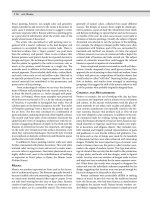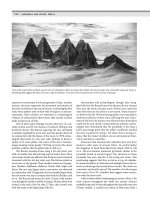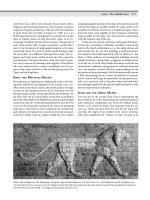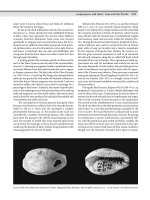Encyclopedia of society and culture in the ancient world ( PDFDrive ) 379
Bạn đang xem bản rút gọn của tài liệu. Xem và tải ngay bản đầy đủ của tài liệu tại đây (63.67 KB, 1 trang )
328
drama and theater: Africa
that modern theatergoers expect, including costumes, sets,
dialogue, character development, conflict, and a climax. Performances took place outdoors, but the theaters in which they
took place resembled modern theaters, with a stage area, a
backstage area, and rows of tiered seating for spectators. Playwrights competed for honors with cycles of plays, and theatrical festivals were major events. Many of the plays written
by the ancient Greeks, including Aeschylus, Sophocles, and
Euripides, are still performed on modern stages, and their
texts, such as Sophocles’ Antigone and Oedipus Rex, remain
standards in the study of literature. The Greeks, too, began to
distinguish between tragedies and comedies, with the comic
plays of Aristophanes occupying a major place in the history
of comedy. Such plays as satyr plays, with their depictions of
drunkenness and debauchery, provided comic relief for more
serious tragic performances. The ancient Romans continued
the Greek tradition with formal theatrical productions. The
Romans performed Greek plays, but in time they produced
their own playwrights, including Plautus and Terence, whose
comedies are still produced.
AFRICA
BY
MICHAEL J. O’NEAL
The words drama and theater in modern life evoke specific
responses. A person is likely to imagine a theater with a stage,
lighting, and rows of seats for spectators. Dramatic productions in modern life—and among some ancient peoples as
well—are based on a script, usually one written by someone
other than the performers. Theatergoers bring certain expectations to a dramatic performance, expectations about how
the story progresses onstage primarily through dialogue between characters. They expect to see a linear performance,
where the story unfolds in a logical progression from beginning to end. They anticipate a resolution to the story that
provides them with some measure of satisfaction.
Few of these expectations would apply to the drama and
theater of ancient Africa, though in the absence of surviving written texts, it is difficult for historians to reconstruct
the nature of ancient African theatrical performances. To do
so, they often have to extrapolate backward from later times,
finding the roots of later theater in the practices of ancient
peoples. In some cases archaeological findings can shed light
on drama as it was performed by ancient Africans.
The “stage” for an ancient African theatrical performance
could be anywhere, including a private home. Most likely, however, theater was conducted in open-air venues where members
of the community could gather. In some parts of Africa the
baobab tree, a tree of great symbolic significance, continues to
serve as a gathering place for the community. The only lighting
was that provided by fires and torches for presentations after
dark. The “script” for an ancient African theatrical presentation was probably in most cases largely improvised, though
such scripts could be based on traditions, folklore, and legends
that had been passed down through many generations.
In ancient Africa there was a close link between theater
and storytelling. An important member of the community in
most African societies was the storyteller, often referred to as
a griot, who acted as a repository, a kind of living museum, for
the origins, history, and genealogy of the community. Such a
person would have learned mythic stories about the community and then passed them down orally in dramatic presentations to his audience. Such stories could include accounts
of creation, the origins of the people, the lineages of kings,
the origins of animals and the stars in the sky, and perhaps
great victories that were won in battle by the community’s
ancestors. None of these stories would have been new to the
audience. These stories were part of the shared cultural inheritance of a people, so they already knew the characters and
outcome. But like modern theatergoers, they judged the quality of the performance on the level of drama and suspense
that the storyteller was able to build. Sharing an unwritten
text over many generations socialized people into their community and forged social bonds.
The “actors” of ancient African theater were not trained
professionals but could include anyone from the community.
Again, storytellers, who could craft stories and present them
with dramatic flourishes, incantations, repetition, and inflections all designed to capture the attention of the audience,
could be considered among the earliest actors. It is likely,
however, that members of the community participated in
the productions through singing and dancing. In this sense,
theatrical productions took on characteristics of spontaneous community celebrations. Dance in particular was probably an important part of a theatrical performance. In the
absence of a text, the movement of people to the rhythms of
drums and other musical instruments allowed people to take
part in their shared cultural heritage and celebrate events—a
harvest, a successful hunt—with their community. Dance,
music, and song, including “call and response” singing, allowed people to express and reenact the community’s deepest
cultural longings and beliefs and forge a sense of unity and
togetherness.
The most important actors were probably shamans and
other religious figures. While some drama in ancient Africa
had secular purposes and themes, it is difficult to distinguish
the secular from the religious in ancient African life, for daily
activities almost always had some sort of religious significance. This religious significance was often tied to the seasons
and the cycles of the natural world. Religious meaning was
found in virtually everything, from a storm to the emergence
of crops to a flood and so on. Thus, just as modern dramatists
try to interpret the complexities of life by distilling them into
a two- or three-hour presentation, so African shamans and
diviners tried to interpret their world through religious rituals with strong theatrical elements.
A good example of this kind of ritualistic performance
is provided by the San people, often referred to as the Bushmen. Archaeologists had long assumed that the oldest ritual
site in African dated back to about 40,000 years ago. A re-









